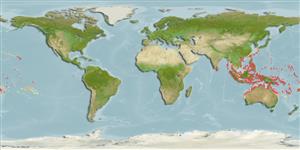Environment: milieu / climate zone / depth range / distribution range
Écologie
marin; saumâtre récifal; profondeur 0 - 15 m (Ref. 1602). Tropical; 32°N - 31°S, 77°E - 130°W
Indo-Pacific: Sri Lanka to the Tuamoto Islands, north to southern Japan, south to the Great Barrier Reef; Palau (Belau) to the eastern Caroline Islands in Micronesia.
Taille / Poids / Âge
Maturity: Lm ? range ? - ? cm
Max length : 18.0 cm TL mâle / non sexé; (Ref. 48636); common length : 15.0 cm TL mâle / non sexé; (Ref. 48636)
Épines dorsales (Total) : 12 - 13; Rayons mous dorsaux (Total) : 21 - 23; Épines anales: 3; Rayons mous anaux: 18 - 20. Body color is yellow with cross-hatched pattern on the sides. A dark black spot is sometimes present under the spinous portion of the dorsal fin. A black bar runs across the eye. The dorsal, anal and caudal fins have a dark stripe the position of which varies with age (Ref. 4855). Snout length 2.1-2.6 in HL. Body depth 1.4-1.8 in SL (Ref. 90102).
An uncommon species found in areas of rich coral growth of lagoon and protected reef flats and seaward reefs (Ref. 9710). Often in pairs (Ref. 9710, 48636). Feed on sea anemones, polychaetes, and octocorallian and scleractinian coral polyps. Oviparous (Ref. 205). Form pairs during breeding (Ref. 205). In captivity, this species should be fed algae stones and the so-called 'feeding stones' which are prepared by spreading the food pulp over the stone. Minimum depth reported taken from Ref. 128797.
Life cycle and mating behavior
Maturities | Reproduction | Spawnings | Egg(s) | Fecundities | Larves
Distinct pairing (Ref. 205).
Myers, R.F., 1991. Micronesian reef fishes. Second Ed. Coral Graphics, Barrigada, Guam. 298 p. (Ref. 1602)
Statut dans la liste rouge de l'IUCN (Ref. 130435)
Menace pour l'homme
Harmless
Utilisations par l'homme
Pêcheries: intérêt commercial mineur; Aquarium: Commercial
Outils
Articles particuliers
Télécharger en XML
Sources Internet
Estimates based on models
Preferred temperature (Ref.
123201): 25.1 - 29.3, mean 28.6 °C (based on 2681 cells).
Phylogenetic diversity index (Ref.
82804): PD
50 = 0.5000 [Uniqueness, from 0.5 = low to 2.0 = high].
Bayesian length-weight: a=0.02291 (0.01133 - 0.04632), b=3.00 (2.83 - 3.17), in cm total length, based on LWR estimates for this Genus-body shape (Ref.
93245).
Niveau trophique (Ref.
69278): 4.3 ±0.0 se; based on diet studies.
Résilience (Ref.
120179): Haut, temps minimum de doublement de population inférieur à 15 mois (Preliminary K or Fecundity.).
Fishing Vulnerability (Ref.
59153): Low vulnerability (10 of 100).
Nutrients (Ref.
124155): Calcium = 88.7 [43.0, 172.9] mg/100g; Iron = 0.725 [0.395, 1.299] mg/100g; Protein = 19.4 [18.2, 20.5] %; Omega3 = 0.133 [0.075, 0.238] g/100g; Selenium = 24 [12, 50] μg/100g; VitaminA = 58 [15, 228] μg/100g; Zinc = 1.33 [0.84, 2.00] mg/100g (wet weight);
